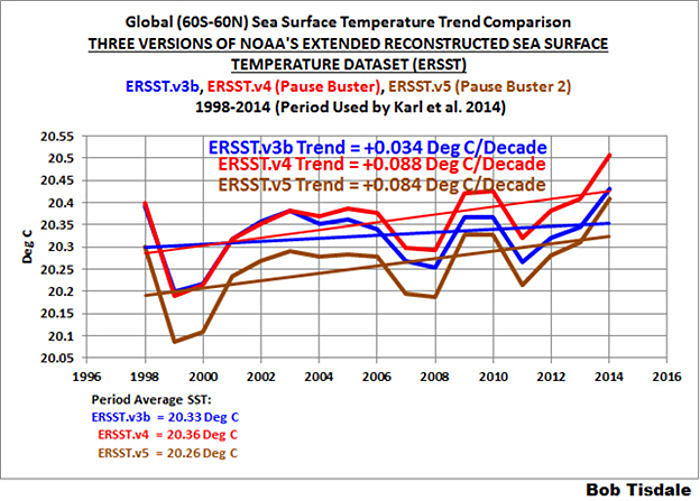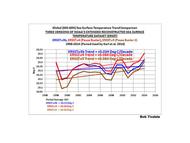Sea Surface Temperature (SST) Anomaly Accuracy
- By:
- Edward A. Reid Jr.
- Posted On:
- Sep 17, 2019 at 6:00 AM
- Category
- Climate Change
NASA GISS recently issued a news release regarding the accuracy of their GISTEMP near-surface temperature anomaly product which is discussed here (GISSTEMP Accuracy). This raised questions about the accuracy of the sea surface temperature anomaly products.
NOAA NCDC focused attention on the sea surface temperature anomaly in the Summer of 2015 with the accelerated release of Karl et al 2015, (ERSST.v4) intended to debunk the idea that there had been a global warming “pause” prior to the climate conference in Paris. This revision to NCDC’s ERSST increased the calculated SST anomaly of approximately 0.6°C (0.92°F) by approximately 0.08°C (0.10°F), or approximately 13%. NCDC has since released ERSST.v5, which reduced the calculated SST anomaly by 0.10°C (0.18°F) below ERSST.v4 and 0.02°C (0.03°F) below ERSST.v3. However, in the process, NCDC increased the rate of increase of SST by a factor of 2.5.

NCDC currently calculates the SST anomaly as 0.8°C. HadSST3 currently calculates the SST anomaly at approximately 0.55°C, while UAH shows the anomaly as 0.45°C. This is a very broad range of values for temperature anomalies which are reported to two decimal place accuracy. The temperatures measured by the Argo Buoys are 0.15-0.45°C lower than the calculated global averages. The difference between the Argo temperatures are smallest compared with the UAH values and greatest compared with the NCDC values. Both ERSST and HadSST use a combination of temperature measurements collected by ships, using various measuring methods, and temperatures measured by the Argo buoys. UAH uses satellite measurements. (Source)
NASA GISS stated that their analysis demonstrated that the “the resulting trends are more robust than what can be accounted for by any uncertainty in the data or methods”. However, there is no real question that the globe is experiencing a warming trend. Rather the questions revolve around the actual magnitude of the warming, the historical rate of warming and the potential future rate and magnitude of the warming. While NASA GISS currently estimates the global temperature anomaly as 0.90°C, HadCRUT estimates the anomaly as 0.70°C and UAH calculates the anomaly as 0.38°C. This is a substantial range of values for anomalies reported to two decimal place accuracy
The graph above from NCDC displays significant uncertainty regarding the magnitude and rate of warming for the period shown. The comparisons with HadSST and UAH display even greater uncertainty regarding the magnitude of the warming of the world’s oceans.
The issues with the land surface temperatures confirm the desirability of establishing a global land surface climate fiducial reference measurements network. The issues with the sea surface temperatures suggest the desirability of establishing a global sea surface temperature fiducial reference measurements network as well. Global temperature measurement has been fraught with inaccurate data, data “adjustments” and data “infilling” for far too long. There is no excuse for such casual treatment of documentation of what some describe as an existential threat to humanity.
However, as serious as the issues with temperature measurement appear to be, the issues with the models used to project potential future temperatures are both far more serious and far more vital.


